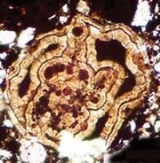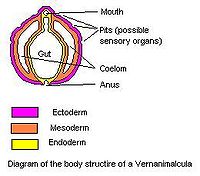
Vernanimalcula
Encyclopedia
Vernanimalcula guizhouena is a fossil believed by some to represent the earliest known member of the Bilateria
(animal
s with bilateral symmetry). It is known from deposits dating to . The fossils are between 0.1 and 0.2 mm across (roughly the width of one or two human hairs). Vernanimalcula means "small spring animal", referring to its appearance in the fossil
record at the end of the Marinoan Glaciation (see also Snowball Earth
).
 The Vernanimalcula fossils were discovered in the Doushantuo Formation
The Vernanimalcula fossils were discovered in the Doushantuo Formation
in China. This formation is a Konservat-Lagerstätte
, one of the rare places where soft body parts and very fine details are preserved in the fossil record. The Vernanimalcula fossils appear to show triploblastic structure, a coelom
, a differentiated gut
, a mouth, an anus
, and paired external pits that could be sense organs
.
The description of Vernanimalcula is not without controversy. Other workers (Bengtson and Budd
) in the field have claimed that it is largely a taphonomic
artefact generated by growth of phosphate within a spherical object such as an acritarch
. Chen et al. have defended their interpretation of Vernanimalcula against the claims of Bengtson and Budd.
The appearance of Vernanimalcula so early in the fossil record has important implications. The radiation of animals into many phyla may have occurred before any animal became much larger than microscopic size. The sudden appearance of many animal phyla in the Cambrian Explosion
may be an illusion. The Cambrian Explosion may instead represent a (geologically) sudden increase in size and the development of easily fossilized body parts by species
in existing phyla.
Bilateria
The bilateria are all animals having a bilateral symmetry, i.e. they have a front and a back end, as well as an upside and downside. Radially symmetrical animals like jellyfish have a topside and downside, but no front and back...
(animal
Animal
Animals are a major group of multicellular, eukaryotic organisms of the kingdom Animalia or Metazoa. Their body plan eventually becomes fixed as they develop, although some undergo a process of metamorphosis later on in their life. Most animals are motile, meaning they can move spontaneously and...
s with bilateral symmetry). It is known from deposits dating to . The fossils are between 0.1 and 0.2 mm across (roughly the width of one or two human hairs). Vernanimalcula means "small spring animal", referring to its appearance in the fossil
Fossil
Fossils are the preserved remains or traces of animals , plants, and other organisms from the remote past...
record at the end of the Marinoan Glaciation (see also Snowball Earth
Snowball Earth
The Snowball Earth hypothesis posits that the Earth's surface became entirely or nearly entirely frozen at least once, some time earlier than 650 Ma . Proponents of the hypothesis argue that it best explains sedimentary deposits generally regarded as of glacial origin at tropical...
).

Doushantuo Formation
The Doushantuo Formation is a Lagerstätte in Guizhou Province, China that is notable for being one of the oldest fossil beds to contain highly preserved fossils...
in China. This formation is a Konservat-Lagerstätte
Lagerstätte
A Lagerstätte is a sedimentary deposit that exhibits extraordinary fossil richness or completeness.Palaeontologists distinguish two kinds....
, one of the rare places where soft body parts and very fine details are preserved in the fossil record. The Vernanimalcula fossils appear to show triploblastic structure, a coelom
Body cavity
By the broadest definition, a body cavity is any fluid-filled space in a multicellular organism. However, the term usually refers to the space located between an animal’s outer covering and the outer lining of the gut cavity, where internal organs develop...
, a differentiated gut
Gut (zoology)
In zoology, the gut, also known as the alimentary canal or alimentary tract, is a tube by which bilaterian animals transfer food to the digestion organs. In large bilaterians the gut generally also has an exit, the anus, by which the animal disposes of solid wastes...
, a mouth, an anus
Anus
The anus is an opening at the opposite end of an animal's digestive tract from the mouth. Its function is to control the expulsion of feces, unwanted semi-solid matter produced during digestion, which, depending on the type of animal, may be one or more of: matter which the animal cannot digest,...
, and paired external pits that could be sense organs
Sensory system
A sensory system is a part of the nervous system responsible for processing sensory information. A sensory system consists of sensory receptors, neural pathways, and parts of the brain involved in sensory perception. Commonly recognized sensory systems are those for vision, hearing, somatic...
.
The description of Vernanimalcula is not without controversy. Other workers (Bengtson and Budd
Graham Budd
Graham Edward Budd is a British palaeontologist, Professor of paleobiology at Uppsala University.Budd’s research primarily has focused on the anatomy and evolutionary significance of Paleozoic arthropods and in the integration of palaeontology into evolutionary developmental biology...
) in the field have claimed that it is largely a taphonomic
Taphonomy
Taphonomy is the study of decaying organisms over time and how they become fossilized . The term taphonomy was introduced to paleontology in 1940 by Russian scientist Ivan Efremov to describe the study of the transition of remains, parts, or products of organisms, from the biosphere, to the...
artefact generated by growth of phosphate within a spherical object such as an acritarch
Acritarch
Acritarchs are small organic fossils, present from approximately to the present. Their diversity reflects major ecological events such as the appearance of predation and the Cambrian explosion.-Definition:In general, any small, non-acid soluble Acritarchs are small organic fossils, present from...
. Chen et al. have defended their interpretation of Vernanimalcula against the claims of Bengtson and Budd.
The appearance of Vernanimalcula so early in the fossil record has important implications. The radiation of animals into many phyla may have occurred before any animal became much larger than microscopic size. The sudden appearance of many animal phyla in the Cambrian Explosion
Cambrian explosion
The Cambrian explosion or Cambrian radiation was the relatively rapid appearance, around , of most major phyla, as demonstrated in the fossil record, accompanied by major diversification of other organisms, including animals, phytoplankton, and calcimicrobes...
may be an illusion. The Cambrian Explosion may instead represent a (geologically) sudden increase in size and the development of easily fossilized body parts by species
Species
In biology, a species is one of the basic units of biological classification and a taxonomic rank. A species is often defined as a group of organisms capable of interbreeding and producing fertile offspring. While in many cases this definition is adequate, more precise or differing measures are...
in existing phyla.

